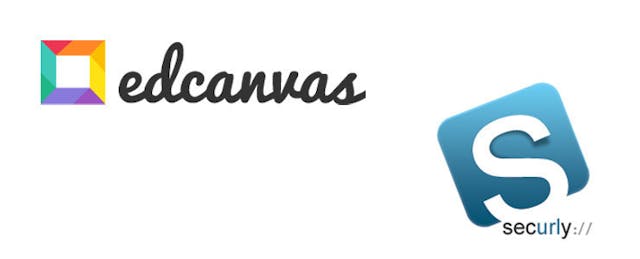This coming Friday is "graduation" day for the third cohort of companies fostered by the Imagine K12 accelerator. Here's where we described the entire program. This week, we're going to start profiling some of the companies. We'll keep going 'till we've covered all 11 newly hatched firms. If you have used or experienced any of these companies, we invite you to share your thoughts in the comments section below.
EdCanvas: a virtual place where teachers can collect and curate digital materials, piecing them together so as to create a lesson for students or to share with other teachers.
Amy Lin, Gabriel Cebrian and Steven Pell met while working at Microsoft in Redmond. They were drawn together by their desire to do something in education. Lin played an active role in Seattle-based Meetups on edtech. She even captured top marks at a Startup Weekend EDU in Seattle around the idea of creating a product to help teachers communicate with their students.
Bolstered by that success, Lin, Cebrian and Pell pitched their idea to the Imagine K12 founders--and it fell flat. The accelerator had just launched a similar product--Remind 101--and wasn't eager to create a second version. But the team members seemed so promising that Imagine K12 offered them a spot--provided they'd come up with a new idea.
Lin and her colleagues poured themselves into research. By Lin's count they interviewed or talked with 200 teachers over about three weeks, probing the problems and frustrations that they experience every day. Their conclusion: Teachers were eager to have an easy place where they could collect, annotate and organize digital materials.
- How it works: anyone who signs up for a subscription account can create a "canvas" and pull in other materials--from videos to URLs to plain old text. They can annotate the pieces, then share their collection with either students or teachers. Anyone can see sample "canvases" on the EdCanvas home page; registered users can see collections of canvases created by others and organized according to disciplines. Teachers can register their students by inviting them onto EdCanvas via email.
- Who's using it: Since the company debuted its service in late September, it has gained more than 1,300 teacher-users, Lin reports. The company met some teachers via Imagine K12's "teacher day." Since then, its growth has been entirely due to word of mouth.
- Business model: EdCanvas will be "always free for teachers," says Lin. She shared two ways the team might eventually make money: charging users for storing large numbers of canvases or building a generic "Canvas" and charging modest fees to its non-teachers users.
- Competition: EdCanvas organizes the materials in its portfolio in a "Pinterest"-kind of way that has also been adopted recently by Grockit's Learn.ist, But while Learn.ist has a big social element, it wasn't designed to help classroom teachers share a lessons with their classes. Edmodo lets teachers "collect" materials --but that's only one element of a larger effort. Similarly Pathbrite lets students create digital portfolios--but it's not as directly tuned to the needs of teachers.
- Check this out: We liked the review of parts of speech, using Schoolhouse Rock. (Alright "Conjunction Junction"!) It will be fantastic to see students starting to put together their own collections of materials.
Secur.ly: A cloud-based technology that lets schools filter web traffic easily and can be extended to cover mobile devices that students bring home.
Blocking nasty content has been a bugaboo for the Web since the first picture drifted through the ether. It got worse when YouTube videos flooded into children's devices.
Vinay Mahadik and Bharath Madhusudan were engineers at McAfee Software and Huawei-Symantec, software powerhouses that provide security software (such as programs for cleaning up computer viruses). As they and their extended families began to have children, the two engineers began to scrutinize how to protect children from unwanted content using the latest cloud-based techniques. Over the past decade, NetNanny has become a popular solution for parents at home. But the downloadable software was designed for parents at home--not schools--and has yet to cover iOS devices.
"The same problem parents have at home is amplified in the schools," says Madhusudan.
- How it works: Secur.ly is licensed primarily to schools. It resides in the cloud so IT administrators do not need to download any software. It comes with a default policy about what to block although administrators can change those options. It provides different levels of privileges for students, teachers and administrative staff. When a child takes home a mobile device, parents opt to extend the Secur.ly software onto the device while it is at home. It also integrates with Google apps--which means that teachers can use their Google sign-on and ensure that those materials are filtered as well.
- Who's using it: Secur.ly has tested its software in approximately 20 pilot schools and is currently working at least five charter schools. It has several paying customers, including AchievementFirst and the Milpitas Unified School district.
- Business model: Secur.ly is selling its software directly to schools for $1,500 per year per school. Parents can sign up without charge to have the software cover mobile devices that children bring home from school. Eventually the company hopes to offer a purely commercial version that would likely have a subscription fee of less than $9 a month.
- Competition: Some schools buy security devices to attach to their network for a fixed cost (which is spread across the device's lifespan of typically four years). Such devices might also involve additional subscription fees to stay current.
- Check this out: Security may seem like a headache, but the company sums up its approach with a 2-minute demo video on its home page.


